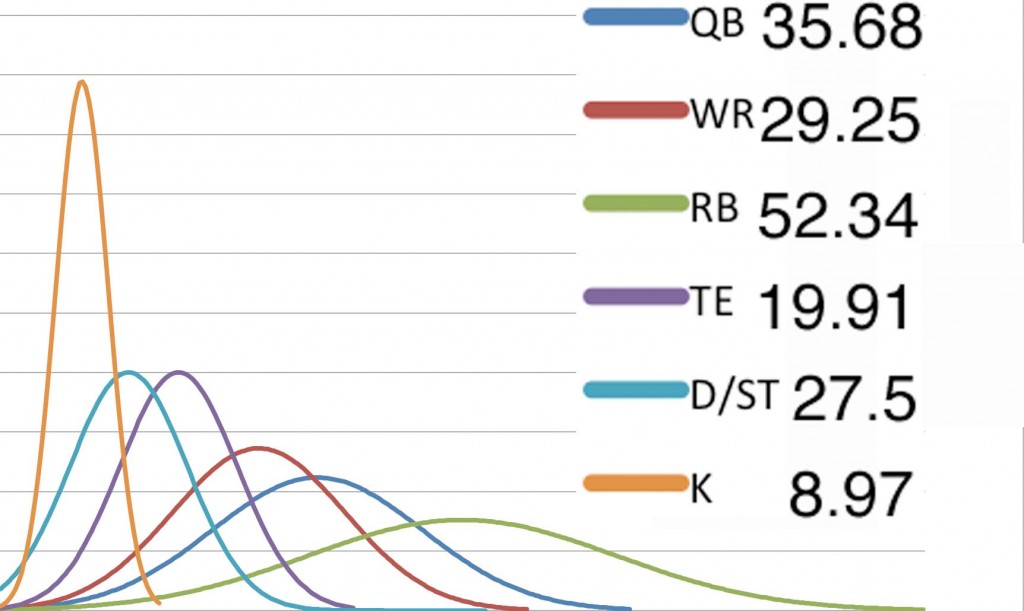I listen to a lot of podcasts. I listen to these podcasts to pass the time and fill my head with information while I go through the monotony of everyday tasks: cooking, cleaning, driving, and doing the dishes.
For me listening to podcasts is a passive activity, which allows me to gain the mental stimulation one derives from being in a conversation, without actually participating in a conversation.
On one of the podcasts I listen to, I heard a pundit proclaim that analysts in the Fantasy community have gone overboard with “running back is shallow/get your running backs early” mantra. And, I thought, have we?
The point of this article is to look at the position depth in Fantasy Football and answer the question, have we gone too far with the running back mantra?
How can we analyze position depth?
As way a to explain a difficult concept, allow me to develop a metaphor.
Say, Derek and Ryan each hook up five girls in one week.
We will use the classic one-to-ten scale as a way to ascribe value to the appearance of the ten girls.
On average, the physical appearance of the girls Derek swoons is on par with the girls that Ryan attracts; the mean appearance of both sets of girls is five.
But, average does not tell you the whole story.
At face value the girls Derek and Ryan have hooked up with over the last week appear to be of the same stock, but the standard deviation of the girls Derek hooked up with is higher than the standard deviation of the girls Ryan hooked up with. Standard deviation is the measure of how spread out a data point is from a data set’s average; the more spread apart the data, the higher the standard deviation. Put another way, the girls that Ryan hooks up with are closer to fives than the girls Ryan hooks up with. Let’s look at the chart:

We will skip the fundamental debate of “which group is better,” because it is a matter of preference,* and it is not relevant to this conversation. What is not a matter of preference is that, if you were to take a girl out of each group at random, put them next to each other, and see which girl is most attractive, more times than not, the girl that Ryan hooked up with would be more attractive. To be exact, sixty percent of the time the girl Ryan hooked up with would be more attractive.
*Feel free to debate in the comments section below, because I would love to hear compelling arguments on each side. But, if you want my opinion, my former roommate Brad reminds me of the time I said, “Two nickels don’t make a dime.”
Derek and Ryan Applied to Fantasy Football
Let’s define what we mean by deep when it comes to Fantasy Football. When we look at what positions are deep, and what positions are not, we look to see what position’s players are closest to the average production for that position. Essentially, you want to know what positions you can wait to draft, because a player who is projected to be 10th at a position is essentially no different than a player who is projected to be 20th at that position.
For this project, I took the top 15 quarterbacks, 30 running backs, 30 wide receivers, 15 tight ends, 15 D/STs, and ten kickers from 2013 and calculated the standard deviation for their position based on last season’s scoring—points were determined by ESPNs standard scoring for 2013. Once I calculated the standard deviation, I plotted the standard deviations on a distribution curve so we could visually see how spread out some positions talent was in 2013, relative to other positions.
Here is what I came up with (next to each position is the standard deviation for that group):

So remember, the higher the standard deviation is, the more spread out the data points are.
To continue the earlier metaphor, which I am not sure if I can stretch much farther, if we put Derek and Ryan on a spectrum, with Derek at one end and Ryan at another, according to the points by position from last year, running backs would be the closest to Ryan’s end of the spectrum (talent resides with few), and kickers would be the closest to Derek’s end of the spectrum (talent resides with many). If we played in a Fantasy league where the girls Derek hooked up with were a position, and the girls Ryan hooked up with were also a position, I would make sure that I drafted a girl Derek hooked up with long before I took a girl Ryan hooked up with; you don’t want to get stuck with any of those twos and threes, just like you don’t want to get stuck with a crappy running back.
For the group of players in this sample, the running back’s individual performance averaged out to be 162 points for the season, while the wide receiver’s production averaged out to be 154 points for the 2013 season. So, not only did running backs average more points than wide receivers, the running backs standard deviation was approaching a total that was almost twice the size of the wide receivers. Conversely, the points that were produced for running backs were the result of a small group of elite individuals (i.e. Adrian Peterson and Arian Foster), while the points that were produced for wide receivers were the result of a large group of players who contributed similar value.
Has the talk about running back being shallow gone to far? Hell no. Let this information reinforce what you know; get your running backs early; wait till the last two rounds to get your kicker and defense; and let someone else take Rob Gronkowski, because you will like your team a lot better if you don’t take a tight end in the first five rounds. Position depth is important to remember while you draft, but these results show you how important it can be.
Devon Jordan is obsessed with statistical analysis, non-fiction literature, and electronic music. If you enjoyed reading about position depth in Fantasy Football, follow him on Twitter @devinjjordan.
























